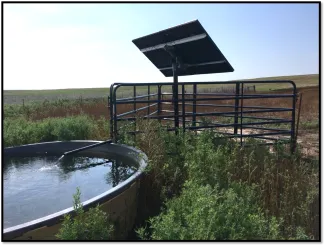
Solar-powered water wells are a popular way of providing water for livestock. This practice allows landowners and managers to provide water in remote and targeted locations to benefit grazing. It also helps managers improve animal distribution that will promote even grazing and reduce pressure on sensitive areas. However, the benefits of solar-powered water wells extend to wildlife too.
Whether in eastern Oklahoma or western, water is one of the three basic needs for wildlife. Water developments aren’t needed for all properties, but where managing existing water sources is unfeasible or where ponds or wetland developments are not recommended, solar-powered water wells can be an option. These solar wells can be used by wildlife as a primary or secondary water source and are important especially during drought conditions. Even though not all wildlife requires supplemental water, a ground-level pit pond can be built to catch the overflow to allow use by more species. Mourning dove, elk, mule deer, white-tailed deer, wild turkey, and numerous songbirds are well known to use the water that is readily available at solar wells.
Another benefit of solar-powered water wells are the micro-habitats they help produce. Solar well pit ponds and their moist-soil peripheries produce vegetation “oases” rich with wetland and aquatic vegetation. Toads, lizards, turtles and many other amphibians and reptiles can be found using these moist-soil areas. Birds, including quail, also use these insect-rich sites to forage and/or escape the summer heat.
Fish may not come to mind when considering a solar well, but sunfish, minnows, and other species can be used to help keep the water trough clear, elevating this water source for more species. Interestingly, managers are using game cameras with cellular technology to check the use and operation of the solar-powered water wells by livestock. These cameras are a great way to monitor the wildlife use and value of these unique water sources too.
The Wildlife Department has technical assistance and limited cost-share to help landowners and managers provide water in remote areas. To be approved for cost-share, there cannot be any water source within a mile of the proposed location. A small pit pond is required for overflow and to allow more wildlife species access to the water.
Contact your local private lands biologist for more information.